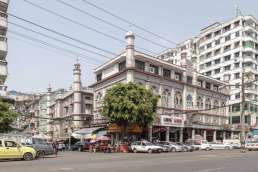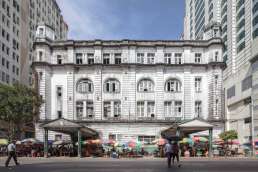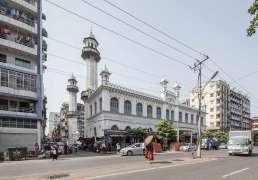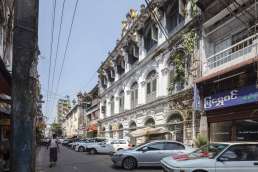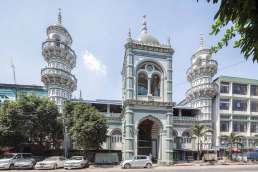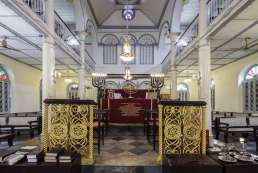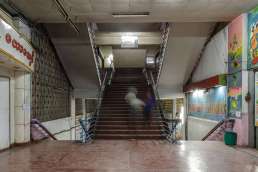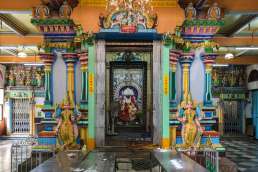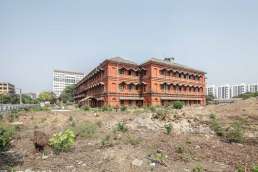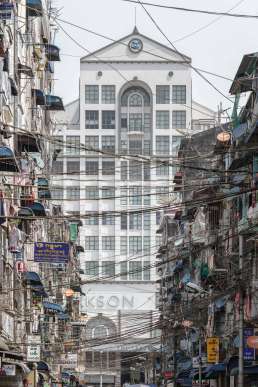Cholia Jamah Mosque
Address: 114 Bo Sun Pet Street
Year built: 1936
Architect: AC Martin & Co. (contractors)
This mosque and its trust occupy several land plots on the corner of Bo Sun Pet Street and Mahabandoola Road. Its history began in 1856 when two men, Gulam Hoosain and Shaik Madar, purchased the first plot and erected a timber mosque. A religious trust, or waqf, was created in 1869 to manage the mosque and administer the income from a number of shops built on an adjacent plot on Mahabandoola Road. The first stone mosque opened three years later, but it wasn’t until 1936 that the current structure was erected.
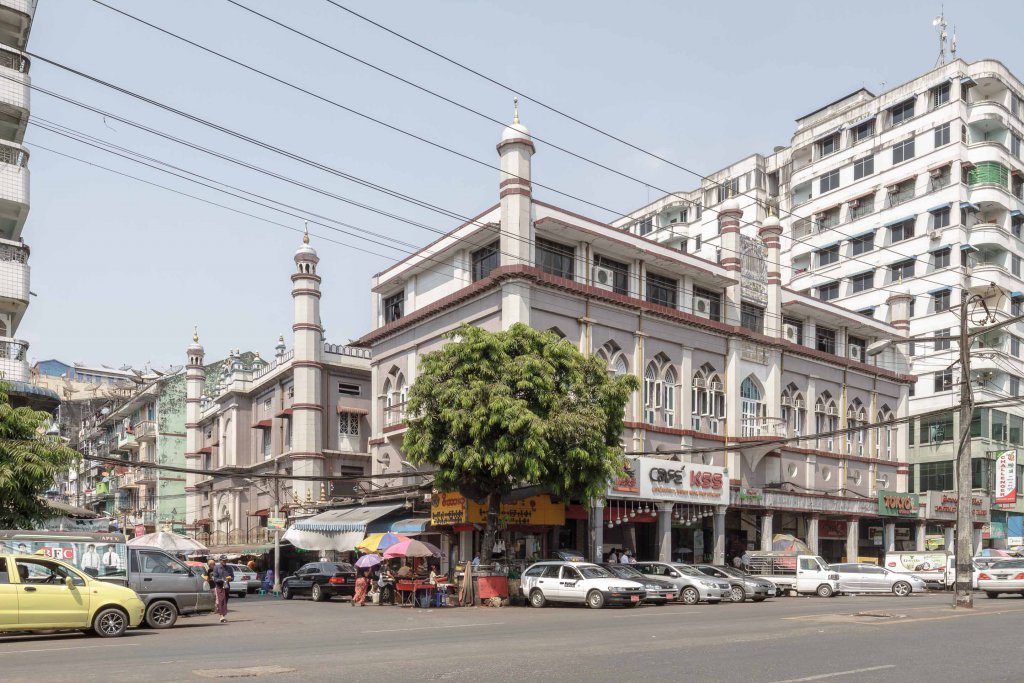
Of the six tenders received, contractor AC Martin was chosen. Martin, or Martirossian as he was known in the Armenian community, came to Burma from Persia and joined the Public Works Department in 1886. He set up his private firm in 1900 and subsequently built many of colonial Rangoon’s buildings, including the General Post Office on Strand Road. That his company built one of the city’s central mosques is a telltale example of Yangon’s cosmopolitan fabric.
The new mosque was built in only seven months. Public infrastructure was chronically poor, and the shortage of water prompted the trustees to install a well in the courtyard. Later, a generator-powered well was added. (Note the large fish swimming in the pond immediately as you enter the mosque.) Whenever there was a shortage of water, the mosque’s wells provided for the neighbourhood. The mosque and especially the buildings surrounding it sustained heavy damage in the war. The portico covering the pavement on Mahabandoola Road was built in 1955. A large hall for the trust was opened in 1963. To build it, the trust had to sanction the removal of a minaret on the corner of Mahabandoola Road and Bo Sun Pet Street.
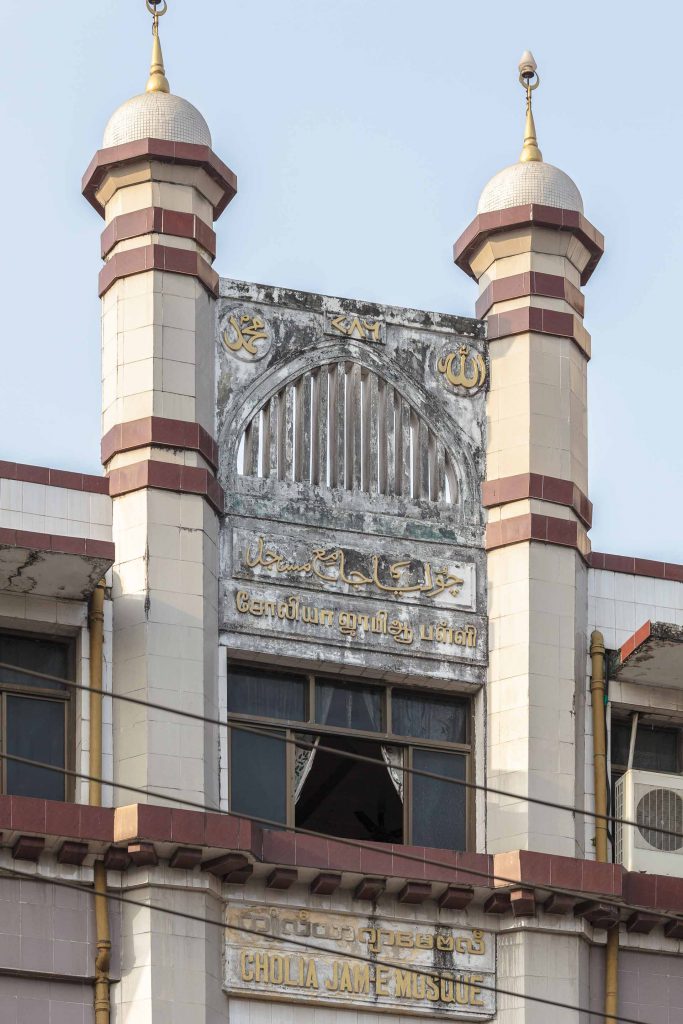
The Supreme Court of Rangoon ruled in 1936 that the term “Cholia Muslim” denotes every Muslim whose mother tongue is Tamil. Etymologically, “Cholia” has its origins in the ancient Indian kingdom of Chola (9th–13th century AD), situated in today’s Tamil Nadu. Muslim traders from this part of India have a long history of traversing the Bay of Bengal, which long predates the arrival of Western colonists. Under British imperial rule, they increasingly settled in Burma, especially Yangon. Many returned to India in the wake of the Japanese occupation and after independence. In his Crossing the Bay of Bengal, the historian Sunil Amrith points us to the “Burma Bazaar” in Chennai, set up by returnees from Burma in the 1960s, and the fact that “many Tamil towns still have a ‘Burma Colony’”.
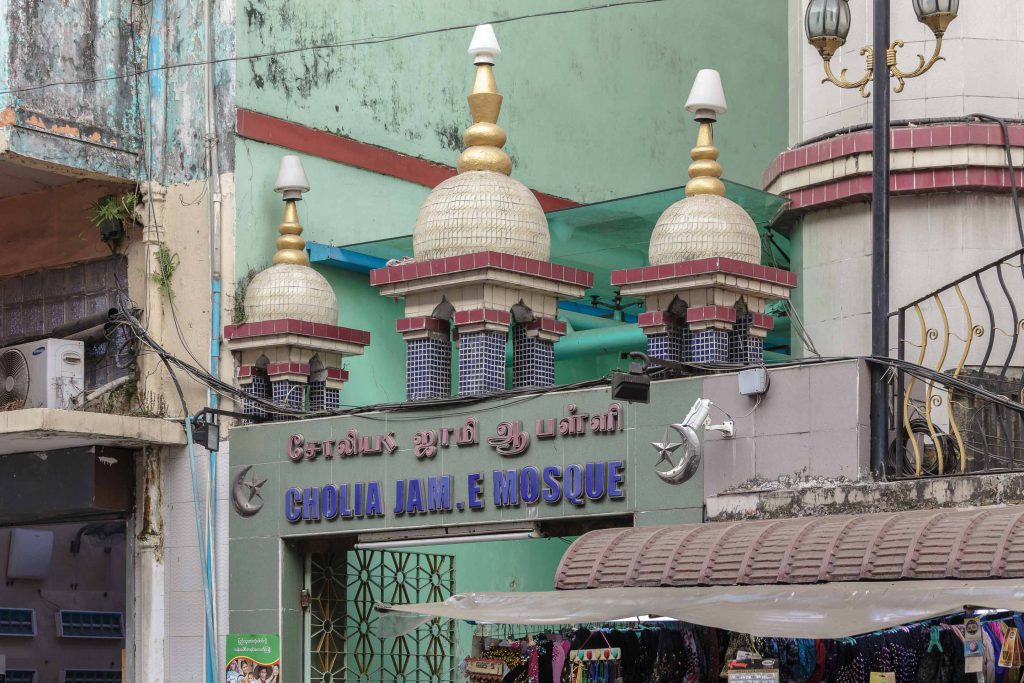
By 2004, the Cholia Muslim Religious Fund Trust was run by about 100 well-off Tamil Muslims, although the mosque also welcomes non-Tamil Sunnis for prayers. The charity organisation assists the poor from the Muslim community, notably poor elderly women. It also ran computer classes and a HIV/AIDS awareness campaign.
The lassi shop between the entrance of the mosque and the corner of Mahabandoola Road is a highly recommended pit stop during your downtown adventures.
Former Myanma Oil and Gas Enterprise Building
Formerly: Burmah Oil Company
Address: 604-608 Merchant Road
Year built: 1908
Architect: Robinson & Mundy (contractors)
Built as an office for the Scottish trading firm Finlay, Fleming & Co., this elegant building later became the Rangoon headquarters for the Burmah Oil Company (BOC). Two towers flank its sides. The four-storey edifice has two entrances with porticos covering the entire pavement. It once dominated this section of the road—but today, it looks a little lost between a large condominium building and one of the Centrepoint Towers.
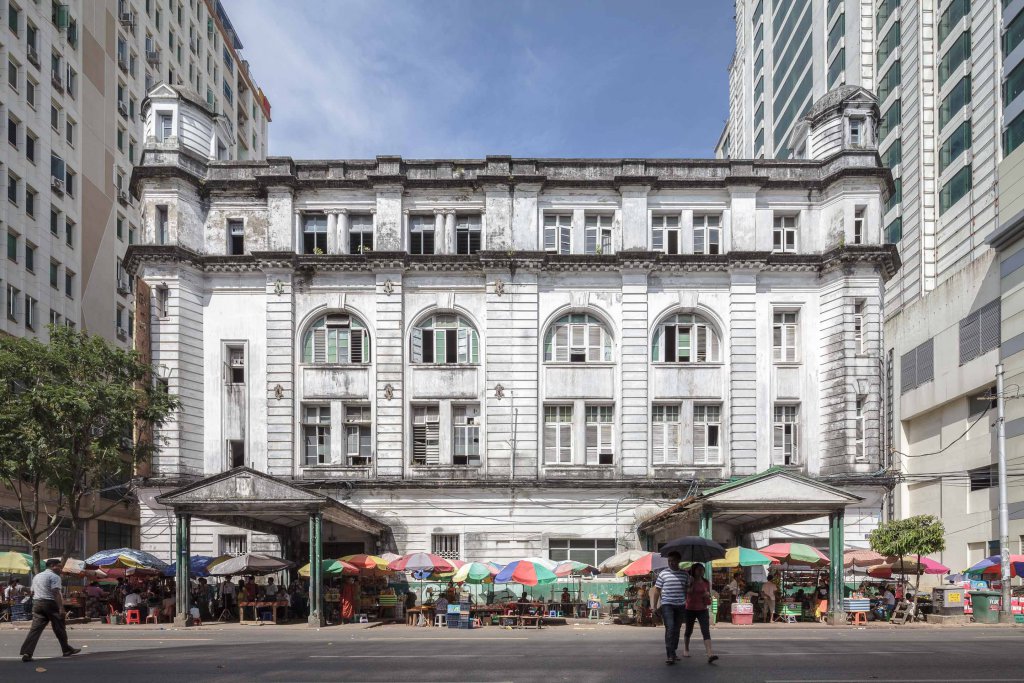
Along with rice and teak, oil was another of Burma’s key resources to become exploited by the colonial enterprise—and BOC enjoyed a virtual monopoly. Before the advent of electricity, the company’s candles and kerosene lamps lit homes not just in Burma but around the world. BOC’s heyday was in the 1920s, when it was one of Britain’s largest industrial firms by revenue. At the time, its operations spanned large parts of the British Empire. BOC’s main agent in Burma was Lim Ching Tsong, whose palace in Bahan township was evidence of the riches that oil could already command at the time. After the war, the business was downscaled and the building on Merchant Road shared premises with a nursing home, known as San Pya Clinic. Burmah Oil was nationalised in 1963 and would eventually become Myanma Oil and Gas Enterprise (MOGE). Today, MOGE’s headquarters are inside the Ministry of Energy in Naypyidaw, while the Yangon building is mostly empty. There is evidence of basic repairs made in the wake of Cyclone Nargis in 2008. (Heritage buildings vacated by the government proved to be especially vulnerable to the cyclone.) In front of the building, the street bustles with market and food stalls as several bus lines terminate here.
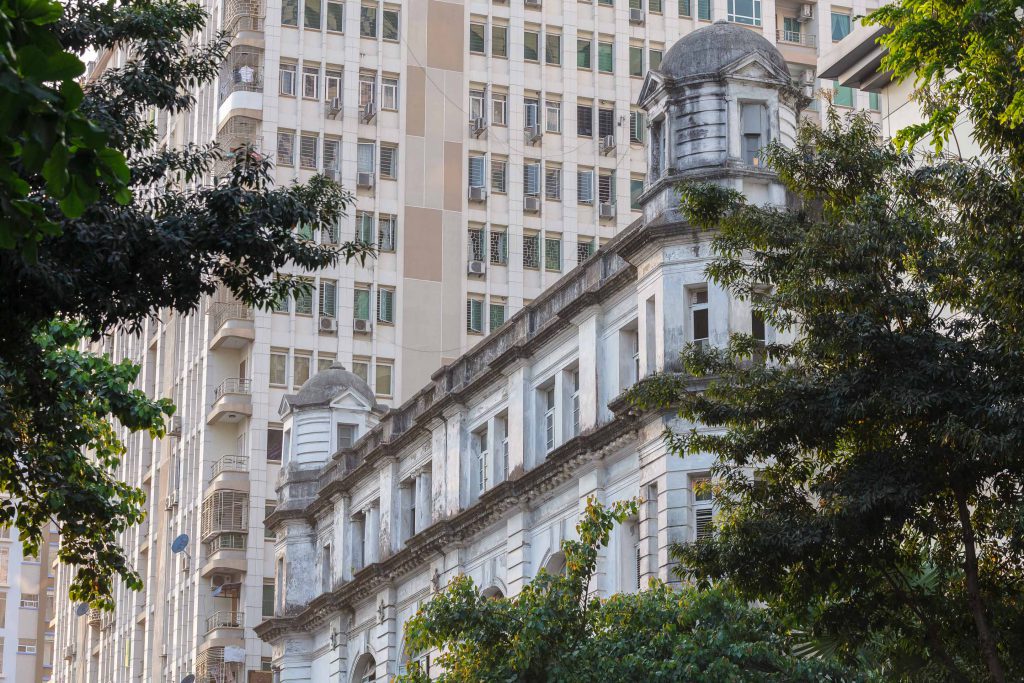
While no exact measures of Myanmar’s current oil and gas reserves exist, some believe them to be sizeable. Recent licence auctions have seen a “who’s who” of the global oil industry partner with local Myanmar companies for their slice of the pie. Some more obscure entities are also getting involved, and in many cases the award of a licence is not known to the public. Civil society organisations have lamented the lack of transparency in the process. One of these, Global Witness, undertakes investigations to uncover this information.
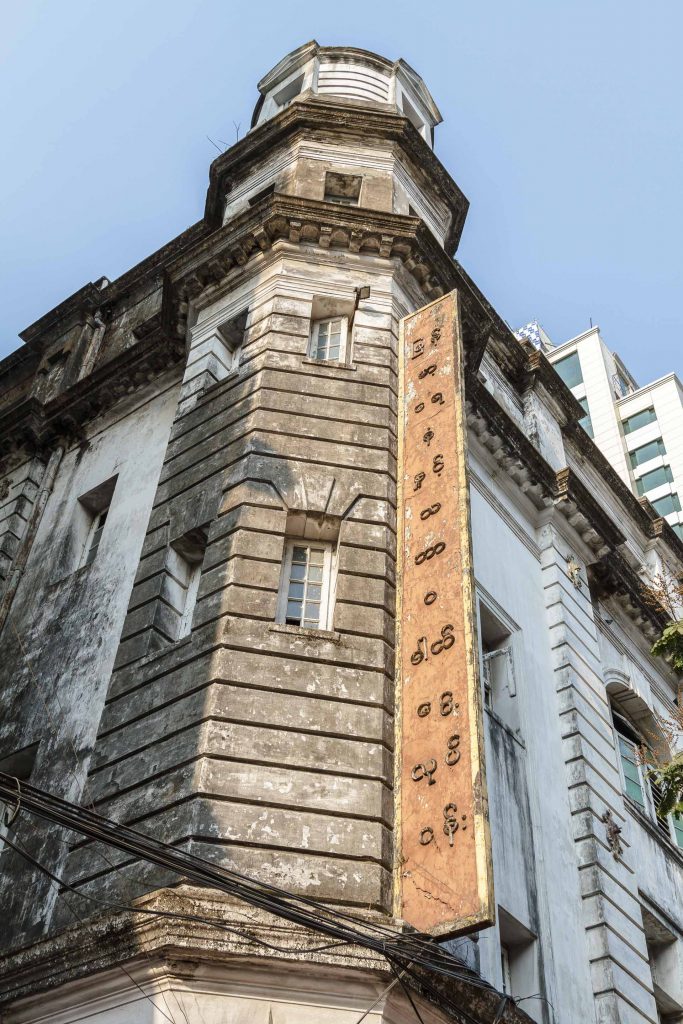
Mogul Shia Mosque
Address: 91 30th Street
Year built: 1914-1918
Architect: Unknown
While there are many Shia in India, the majority of Indian Muslims who migrated to Burma were Sunni. Thus, there were only ever a few Shia mosques in Yangon. This is the community’s largest. It dates back to the mid-19th century, when Indo-Persian merchant families erected a wooden house of worship in 1854. By the entrance, a well even predates the first mosque: it was dug by order of colonial officer Sir Arthur Phayre in 1852 (at a time when sanitation was a major challenge in the fledgling city). The current structure was built between 1914 and 1918 and remains largely intact in its original form today. The mosque occupies a wide plot between 29th and 30th Streets along Mahabandoola Road. Its main entrance is on 30th Street. Despite the dense urban layout of the vicinity, the two large minarets stand out from afar. The mosque itself is set back from Mahabandoola Road behind the large Mogul Hall, which accommodates worshippers and those on business passing through the city. A recent paint job and interior restoration have kept the entire complex in good shape.
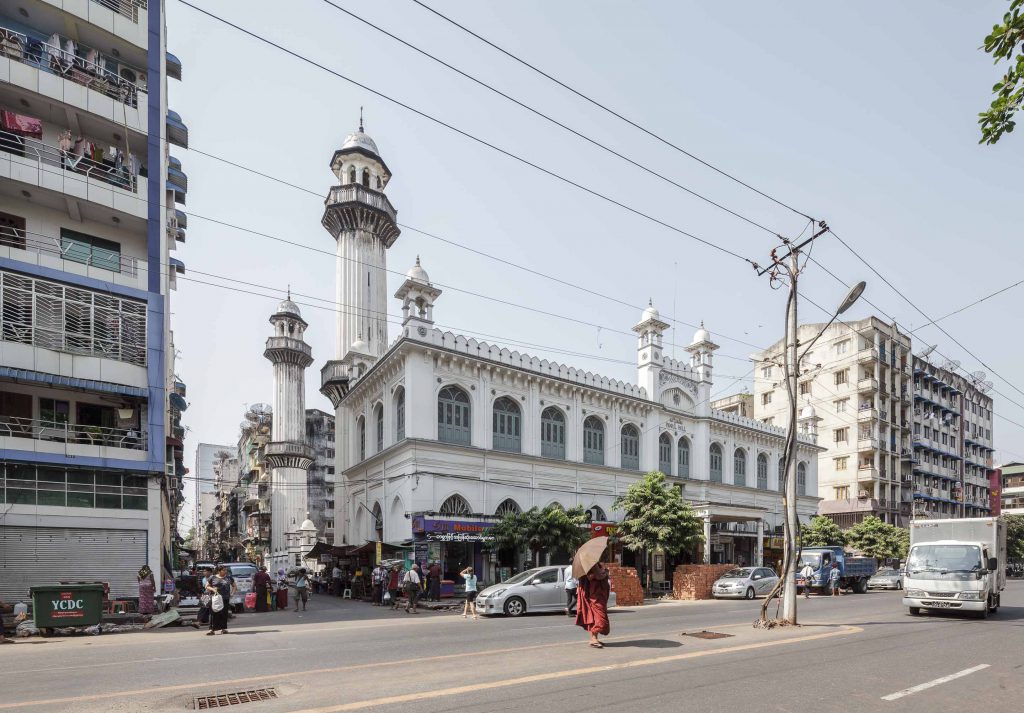
The Indo-Persian merchants who set up this mosque hailed from Persia by way of India. The board of trustees comprised men named Kabuli, Ispahany, Sherazee and Khorasanee, to name a few, which give us strong clues about their geographic origin. The history of one family bearing the latter name is exemplary. In his self-published autobiography, S Afsheen explains that his great-great-grandfather, Hasan Ali Khorasanee, came to Burma in the 19th century where he, like other “Iranians”, was given preferential trading terms by the Burmese court. Hasan Ali’s father, Ashraf Afshar, was an adviser to the royal court in Delhi. The Burma-based Khorasanee family became a powerful family trading firm over the next generations. S Afsheen’s great-grandfather, Backer Khorasanee, owned several villages and other properties in Rangoon as well as a thriving business trading in leather and other merchandise, which he sold in his department store on Mahabandoola Road. His own house stood on 31st Street. S Afsheen’s maternal grandfather, Mohammed Hashim Ispahany, was one of the original trustees of the rebuilt Mogul Mosque alongside the adjoining Mogul Hall.
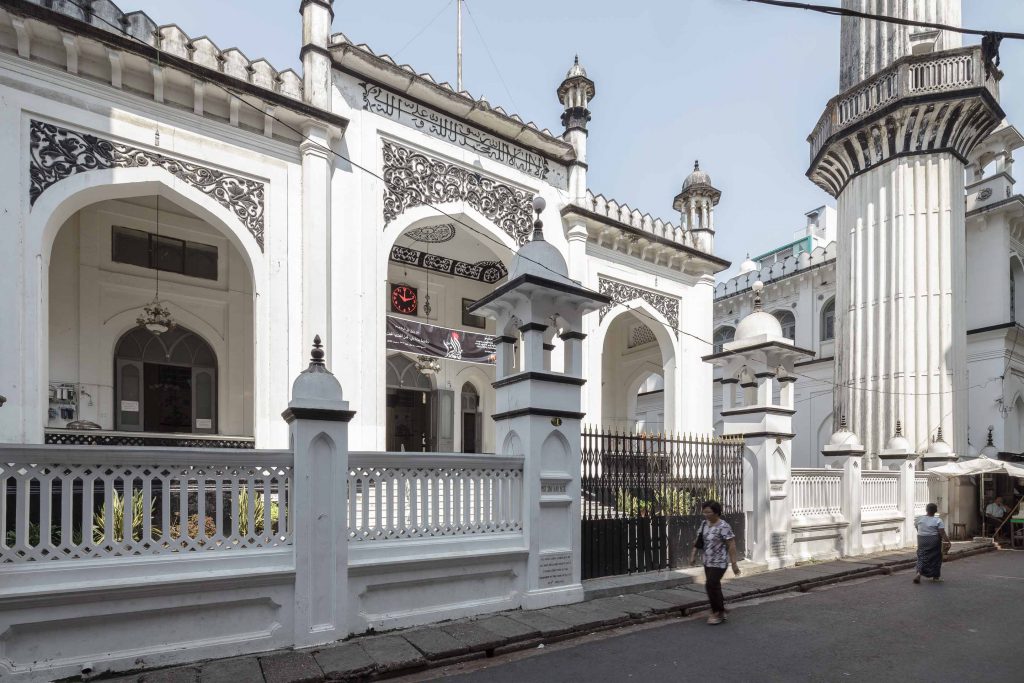
Two engineers of a British firm were selected to plan and oversee the construction. According to S Afsheen, they were sent to India to select a design for the mosque. They were particularly impressed by the Taj Mahal in Agra.
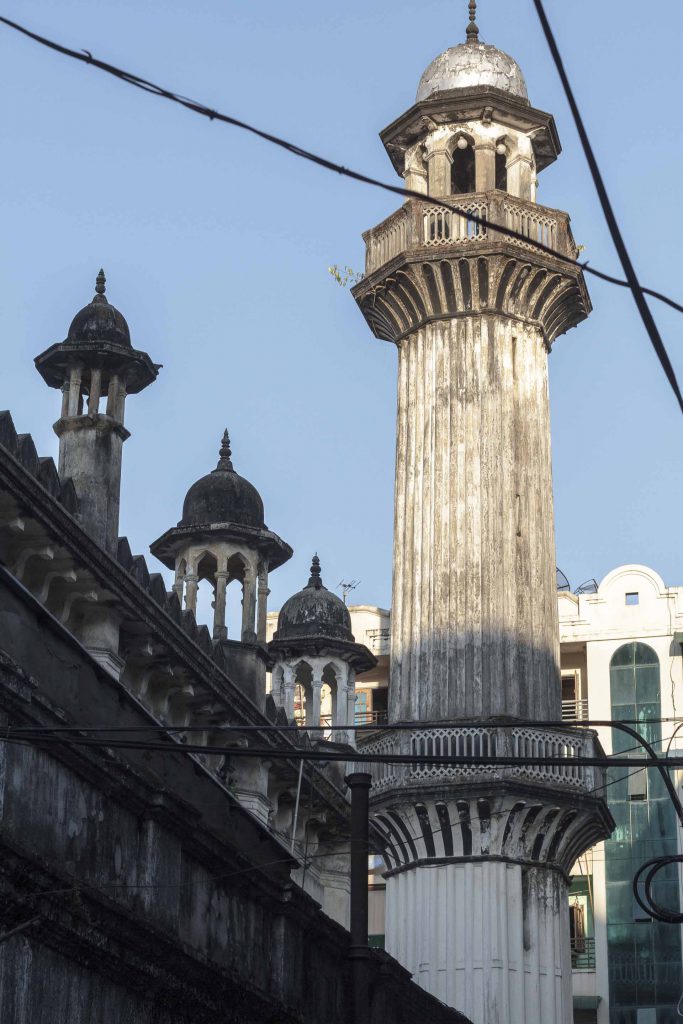
The Day of Ashura, the 10th day of the month of Muharram, is regularly observed by the Shia community in Yangon, today about 2,000 strong. The ceremony is held in honour of Hussein, who died a martyr in the battle of Karbala—a historic clash between Shia and Sunni in present-day Iraq, in the 7th century AD. Around the world, Shia mark this as a day of mourning. It involves spectacular and masochistic rituals, mainly by Shia men. For example, they walk barefoot across hot coals or lash themselves with long chains of blades.
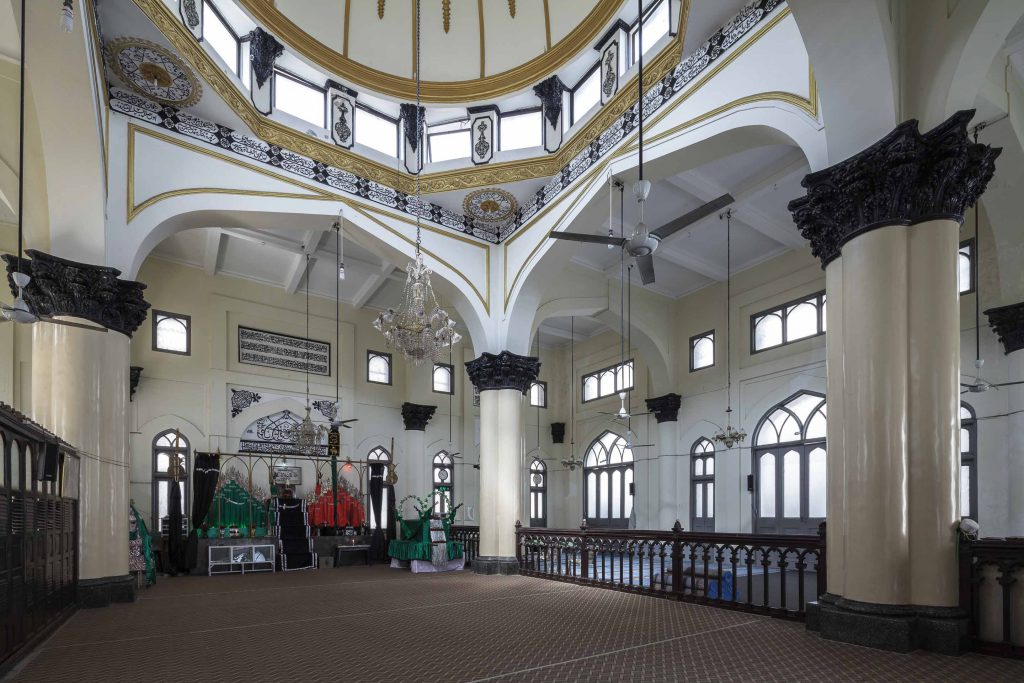
Jain Temple
Address: 74-78 29th Street
Year built: 1914
Architect: Unknown
This building on narrow 29th Street may not strike you as a temple at first: its design is closer to the city’s official colonial-era architecture. One clue, however, lies in the two golden lion figures on the roof. These represent Mahavira, the most recent of Jainism’s 24 Jinas—liberated beings who can help others achieve liberation themselves. The result is an interesting mix of religious carvings on an otherwise neoclassical façade. The signpost on the entrance, “Shree Jain Shwetamber Murtipujak Temple” denotes the sect and sub-sect of Jainism to which this temple belongs. Murtipujaka differs from other Jain sects in that its temples contain idols instead of being empty.
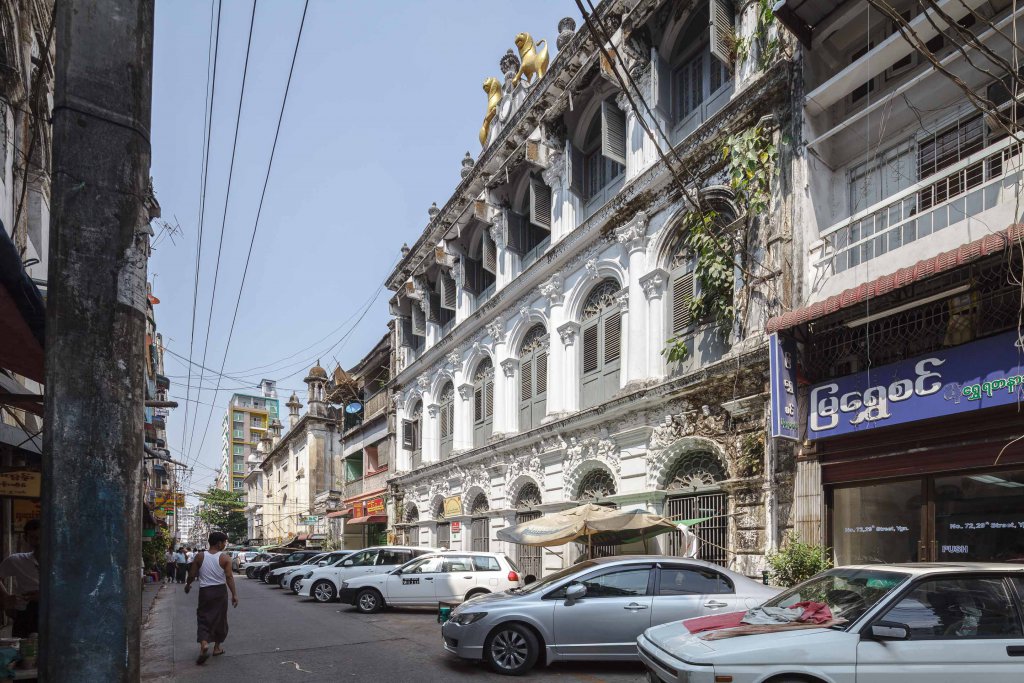
Jainism is one of India’s smallest but oldest religions, numbering about five million believers. Its most famous principles are nonviolence and strict vegetarianism. During British rule as many as 10,000 Jain lived in Rangoon. The community’s first temple, occupying the top floor of a building inside the Surati Bazaar (today’s Theingyi Market), was founded in 1899. Most Jain left the country during the Second World War and after the Ne Win coup of 1962. No exact figures exist as to today’s Jain population in Myanmar. Some sources state that Myanmar as a whole is home to 2,000 Jain. Others speak of only five Jain families remaining in today’s Yangon. Most Jain originally hailed from Gujarat, contributing to the rich mix of people living in Yangon from this part of India. In contrast to India, there is considerable mixing among the various religions. Paris-based writer Mira Kamdar, who herself has Jain roots through her grandmother’s line, recounts a visit to Yangon in 2000, while she was tracing her Indian ancestors who had once lived in Burma:
“For the first time in my life outside the rarefied circles of the intellectual Westernised elite of New York, New Delhi, or Bombay, I find myself in a world in which Hindus, Jains, and Muslims mix comfortably and even affectionately in each other’s homes, over meals no less. In Gujarat, this kind of easy mixing in people’s homes would be quite extraordinary. Whereas Hindus and Jains and Muslims may be good friends in public spheres, such as school or work, in the private sphere of the home it would be unusual to get together. (…) I found none of that in Rangoon. And, as people brought out their wedding albums and photographs of important community events, it became clear these close relationships across religious lines went back many years, for they had been—the men at least—present at all the important occasions of each others’ lives.”
Surti Sunni Jamah Mosque
Address: 149 Shwebontha Road
Year built: Ca. 1860s
Architect: Unknown
Shwebontha Road used to be known as Mogul (Mughal) Street and was at the heart of “Indian” Yangon. India’s last Mughal emperor, Bahadur Shah Zafar, was exiled to Rangoon after the Indian Mutiny of 1857—the greatest and bloodiest challenge to British colonial rule at the time. Zafar brought with him a legion of courtiers and attendants. Many of the shopkeepers in this part of Yangon claim descent from the exiled court, as Thant Myint-U explains in his book Where China Meets India: Burma and the New Crossroads of Asia.
The first mosque in Yangon was built as early as 1826. (It was destroyed in the Second Anglo–Burmese War in 1852.) In the early 1840s, when Colesworthey Grant visited the city, he observed that besides two churches (the predecessor to today’s Armenian Church and a Roman Catholic Church), were three “Mohummudan mosques, indicating that intolerance in religious matters, at least, is not amongst the fault of the Boodhists”.
The Surti Sunni Jamah Mosque was built some time around the 1860s, and some sources refer to its opening in 1871. This makes the mosque one of the oldest still in its original state, although its exterior is covered in tiles today. Two large minarets flank the mosque and its imposing arched entrance tower protrudes above the pavement.
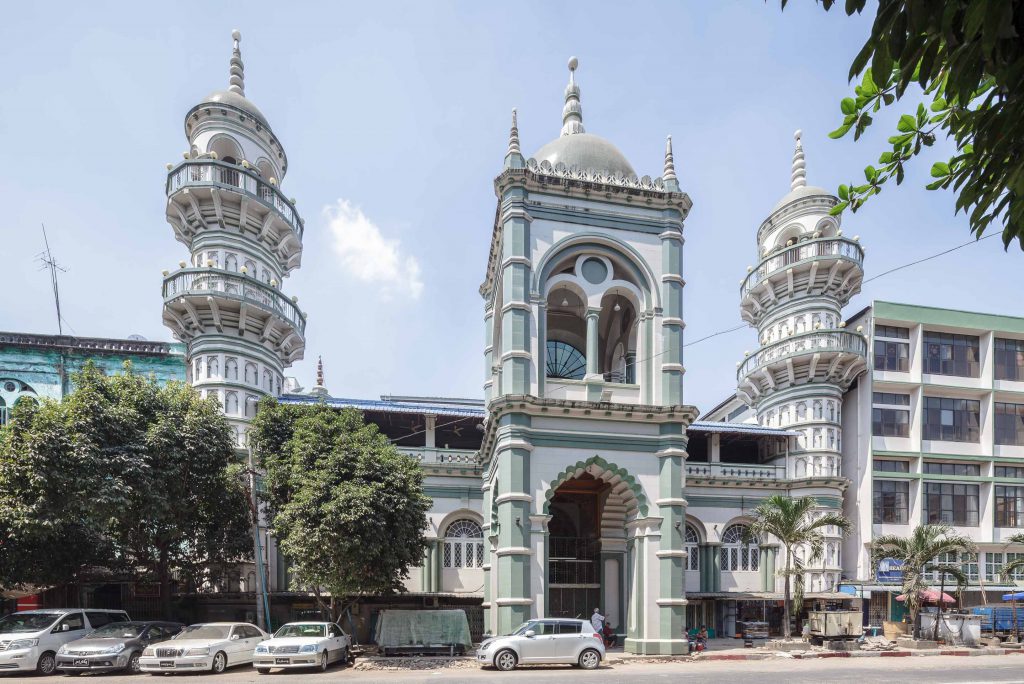
The mosque’s name suggests that it was built by Gujarati traders originating from or near Surat, quite possibly from the town of Rander opposite the Tapi River. Historical links between Rander and Myanmar survive to this day: many old homes in Rander are built with Burmese teak, and the culinary landscape features specialities brought back to India from “Burma Repatriates” during the Second World War as well as Ne Win’s nationalisation campaign in the 1960s. One still finds Rangooni parathas (deep-fried pieces of meat enveloped in a thin layer of wheat dough mixed with egg) and Khow Suey (traditionally a Shan noodle dish, and a close cousin of Thailand’s famous Khao Soi) in restaurants in Rander. If this whets your appetite, head to Golden Chetty Restaurant (115–117 Sule Pagoda Road) or New Delhi (on the corner of 29th Street and Anawratha Road) for some authentic Indian dishes. There is another mosque of the same name on 35th Street, worth visiting for its interesting setting on the narrow road.
Musmeah Yeshua Synagogue
Address: 26th Street
Year built: 1896
Architect: Unknown
Built between 1893 and 1896, the Musmeah Yeshua Synagogue today serves only 20 or so Jewish residents of Yangon. But in the early 20th century up until the Second World War, it was the spiritual home of the Sephardic Jewish community who settled in colonial Rangoon, fleeing Ottoman and Iraqi persecution in Baghdad. Their numbers reached around 2,200. Many of them rose to prominence as businessmen, such as Isaac Sofaer who built the iconic Sofaer’s Building. Others served as magistrates, municipal councillors and commissioners. About half of the community fled in the wake of the Japanese invasion in 1942, often embarking on an arduous overland trek to India. This “forgotten march” cost tens of thousands of lives, mainly Indian.
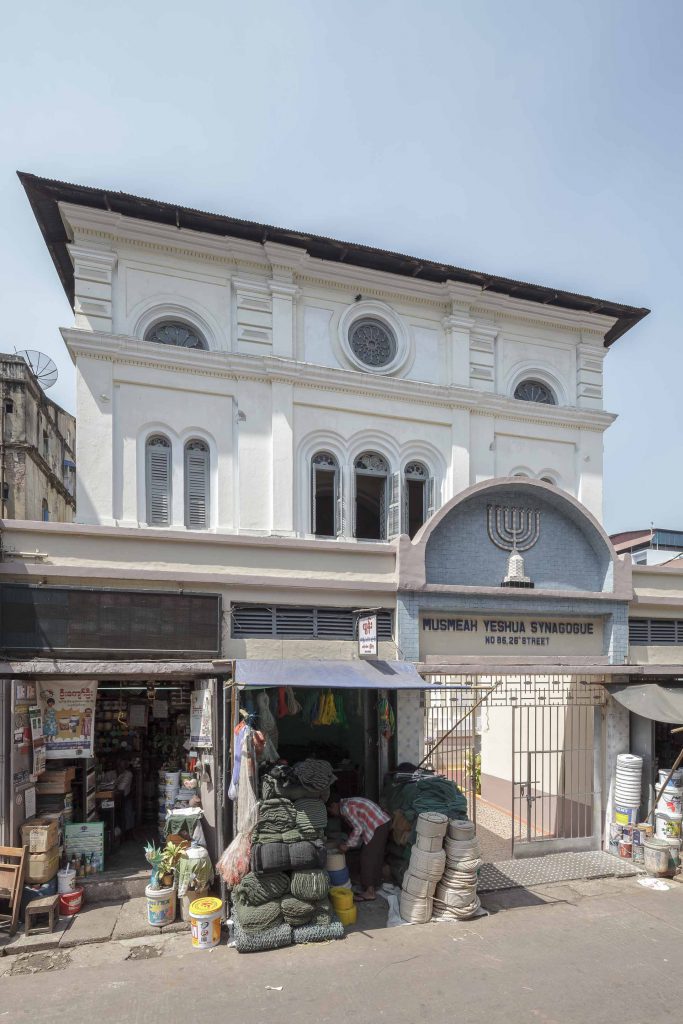
As a result of the war, 1,000 Rangoon Jews settled in Calcutta. Amid post-independence chaos in Burma, most of the remaining Jews emigrated to the newly created state of Israel which, like Myanmar, was founded in 1948. The two countries maintained good relations until Ne Win’s coup in 1962. Burma was the first Asian country to recognise Israel; Burma’s first prime minister, U Nu, travelled to Israel in 1955, becoming the first foreign head of state to do so. Israeli Prime Minister David Ben-Gurion spent two weeks in Burma in 1961. Presidents Ben-Zvi, Meir, Dayan and Peres would also visit the country during their terms.
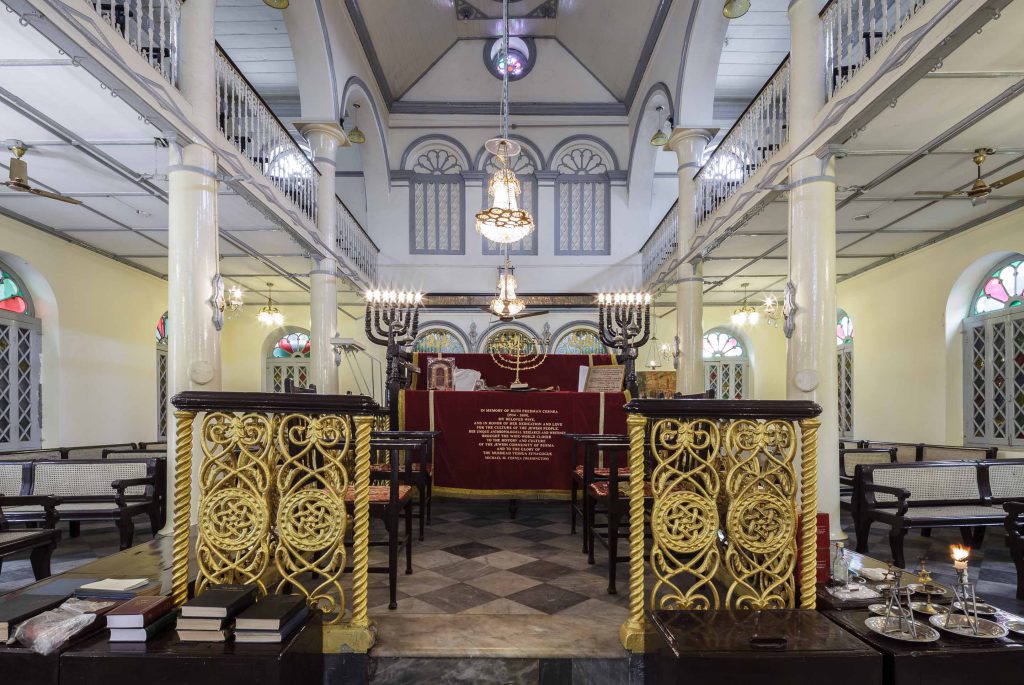
Until recently painted an attractive sky-blue and pale yellow, the synagogue is now white. Set back within a tranquil courtyard, the visitor arrives from an entrance on busy 26th Street, where a menorah adorns the front entrance on a blue tiled background. The inside of the synagogue itself is airy and cool. In a nod to the heat, the benches are cane-seated and fans (along with chandeliers) hang from the ceiling. Note also the arched windows and stained glass.
Although the Jewish population in today’s Yangon is minuscule, the synagogue aims to attract Jewish visitors to Myanmar. One of Yangon’s Jews, Sammy Samuels, describes spending Fridays inside the synagogue with his father in the hope of meeting foreign visitors:
“Every Friday, my father and I used to wait at the synagogue for Jewish visitors until we can gather the minyan (requisite ten people) to begin services. (…) It is my father’s fervent belief that no Jew should be alone during the holidays—and yet most of the time, the two of us found ourselves alone in the synagogue. But even if only he and I are present, I always feel the echoes of the many Shabbat services that took place in this beautiful synagogue and hear the melodies of the songs our ancestors sang when the community was at its peak.”
Sammy Samuels has founded a travel agency, Myanmar Shalom, catering to Jewish tourists.
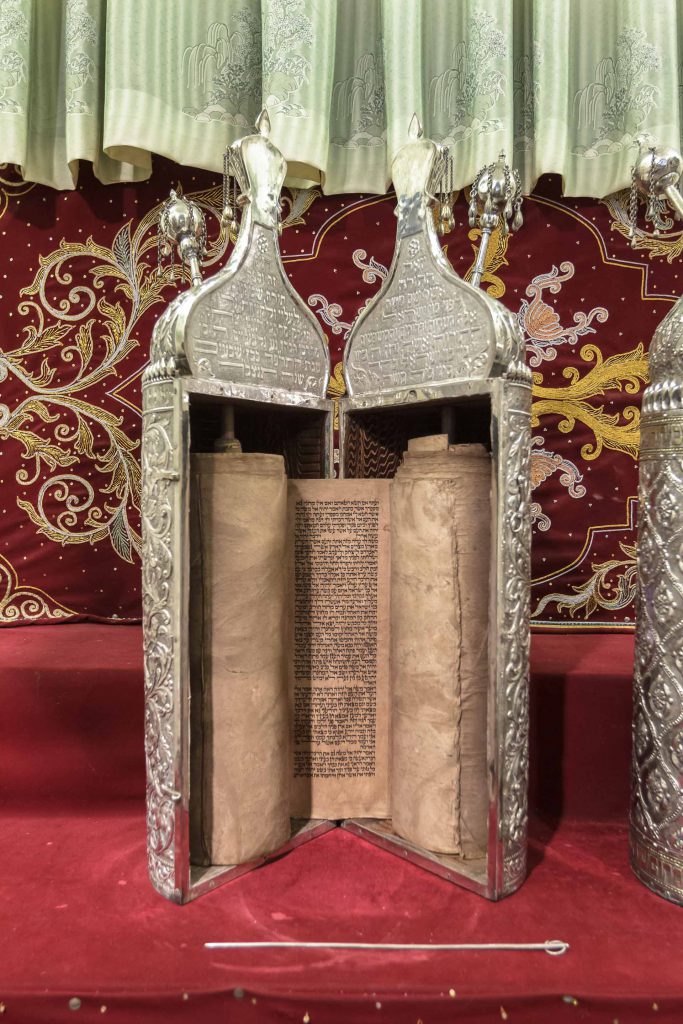
Theingyi Market
Formerly: Surari Bara Bazaar
Address: Mahabandoola Road
Year built: 19th century
Architect: Unknown
Today’s Theingyi Market began its existence as the “Surati Bara Bazaar” in the 19th century. The term “Surati” refers to Muslim immigrants from Gujarat who came to Rangoon and Burma in large numbers during the 19th century. (From 1872 to 1881 alone, the Indian migrant population in the city more than quadrupled to 66,000.) Indian cultures and traditions, from religion to music to food, permeate the streets of this downtown area.
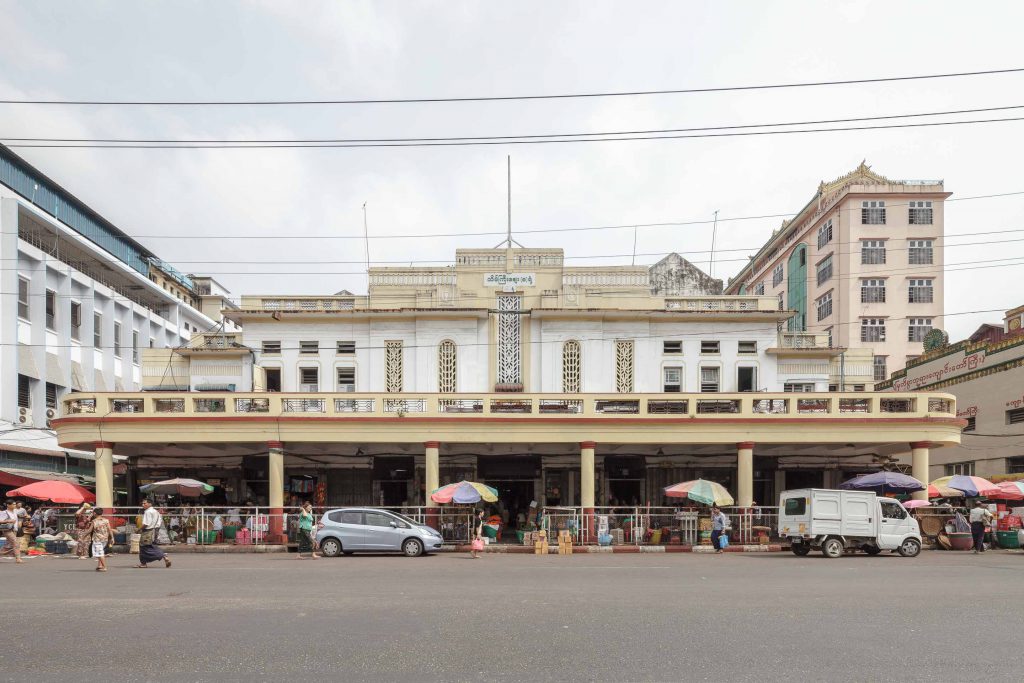
Theingyi attracts a broader, less affluent cross-section of Burmese shoppers and fewer tourists than nearby Bogyoke Aung San Market. The market started in the shade of a nearby monastery of the same name, which attracted many traders even before the British.
After the British began to expand Rangoon, the market area was handed over to Surati traders who built the bazaar. Between the 1850s and the 1900s the market grew, shrank, and was devastated early on by several fires. (Earlier structures were made of thatch.) Today the market consists of five blocks, lettered A through to E. They surround the intersection of Mahabandoola and Shwedagon Pagoda Roads. The “A” and “B” buildings date from 1938 and 1905 respectively. The façade of the B building, on Mahabandoola Road, stands out with its vast portico doubling up as a first-floor balcony, patterned perforated walls and louvred windows.
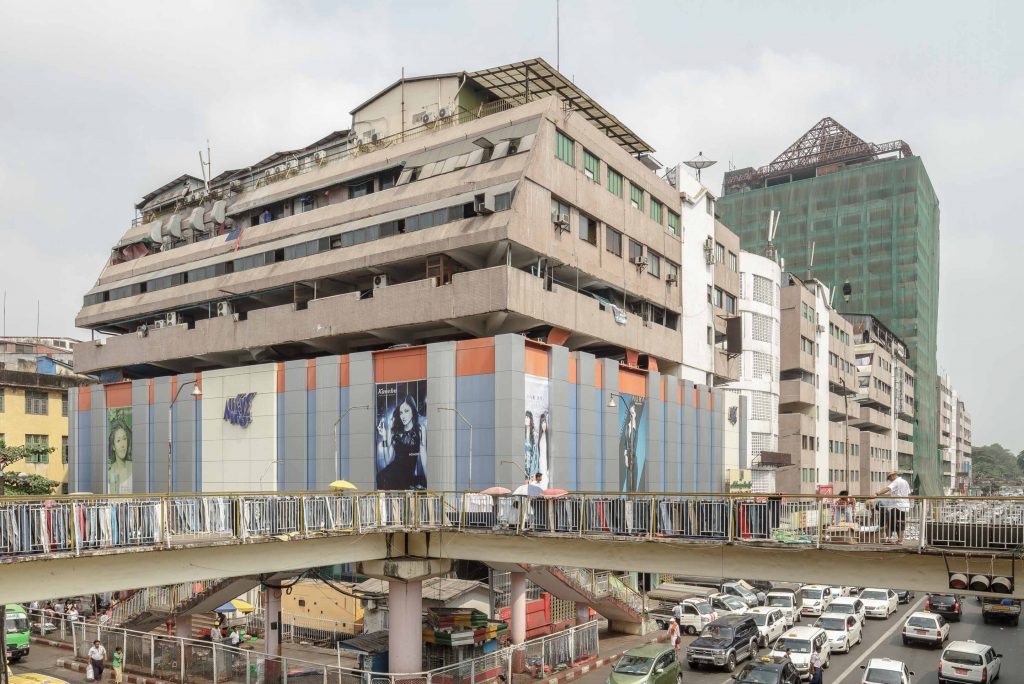
Some blocks were rebuilt post-1988 and are clearly identifiable as such. Block D, with its slanted façade, has a distinctly brutalist feel. Theingyi Market was the subject of a German university study on the concept of “living heritage”—in other words, a building that continues to fulfil its historical purpose. As the lead researcher, Professor Frauke Kraas explained: “You will find long-term relationships among the vendors and also beyond the market to other parts of Myanmar and even beyond. There are long historic roots [with] deep economic and social cohesion.” A visit to Theingyi Market is a definite must-see Yangon experience as grinding traffic, baskets of fresh fish and hollering merchants seem locked in a seamless choreography controlled by higher forces. The contrast with the sanitised alleys of Bogyoke Market tells more and more of—to use a cliché—a tale of two cities.
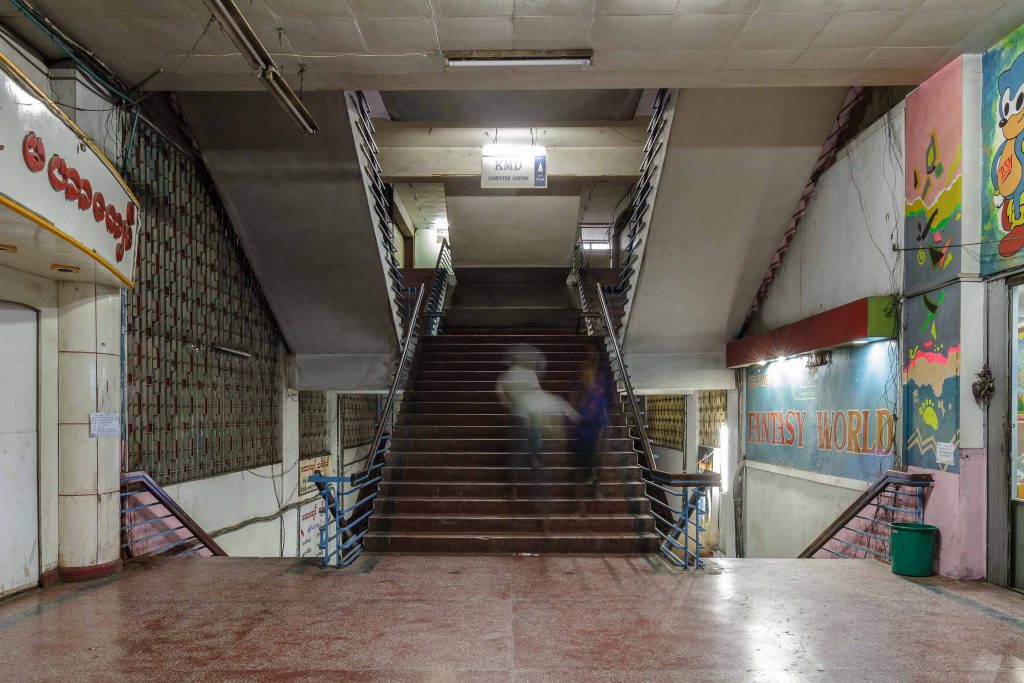
Shri Kali Hindu Temple
Address: 295 Konzedan Street
Year built: 1871
Architect: Unknown
Among the many Hindu temples in Yangon, the Shri Kali Temple is devoted to the goddess Kali (or Kali Ma, as she is also known). The temple was built by Tamil immigrants at a time when the Indian population of Rangoon totalled around 15,000 people, compared to more than 70,000 Burmese and other “indigenous races”, as the census then showed. Only 10 years later, the number of Indians had quadrupled, while the local population remained constant. In the 1870s, then, these droves of new residents required houses of worship for their respective faiths, and in their regional character.
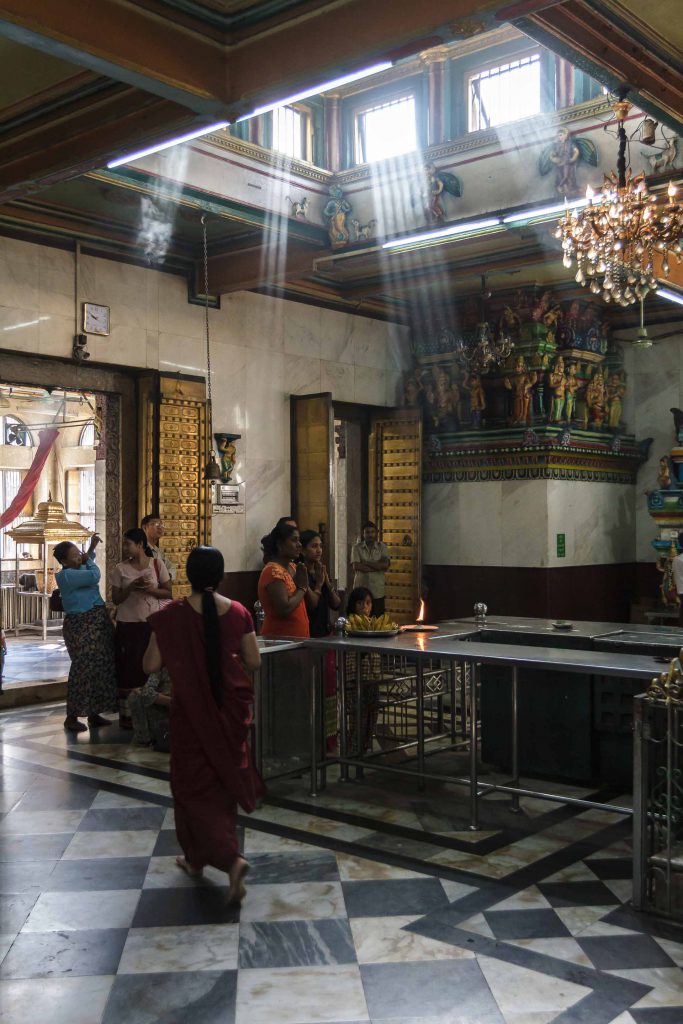
Traditionally depicted in black and in fearsome poses (four arms, carrying the severed head of a demon in one and usually a sword in another), Kali is the goddess of time, change, power and destruction. Many praise her as the greatest of all deities. Her sculpture, inside the sanctum, is richly decorated with flowers. The temple is busy with worshippers, many of them bowing before Kali. Temple assistants are there to help place offerings and apply the tilaka, the red mark worn on the forehead.
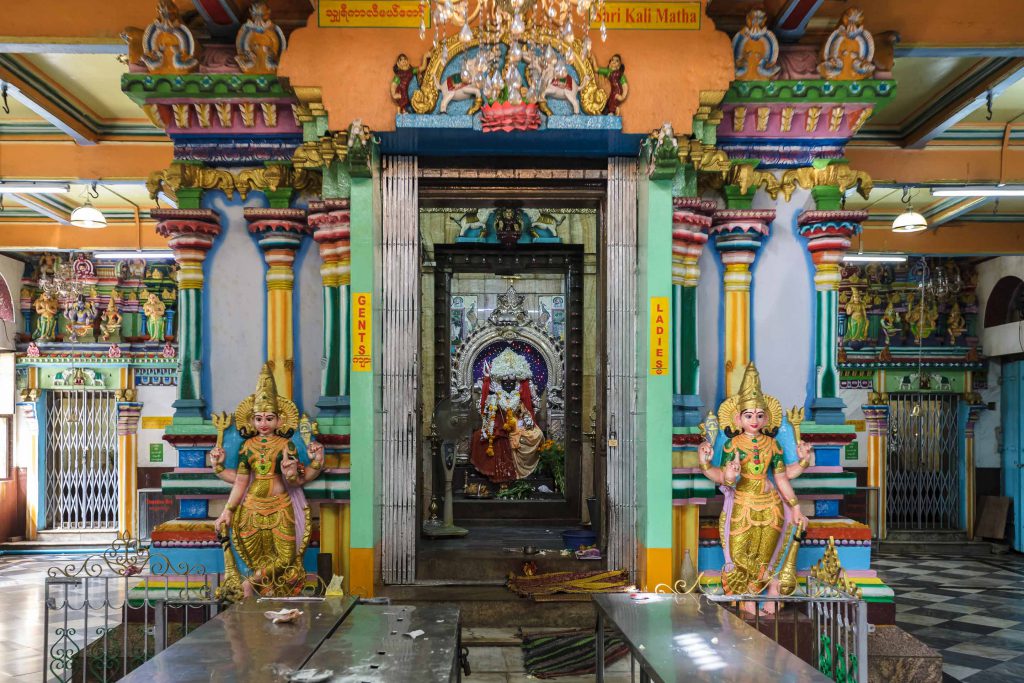
The temple’s colourful exteriors, especially its characteristic tower (gopuram), are recognisable sights. It is richly decorated with sculptures and carvings featuring scenes from Hindu mythology. The power lines above the entrance are usually lined with pigeons, so tread carefully. As in all Hindu temples, footwear must be left outside in the space provided.
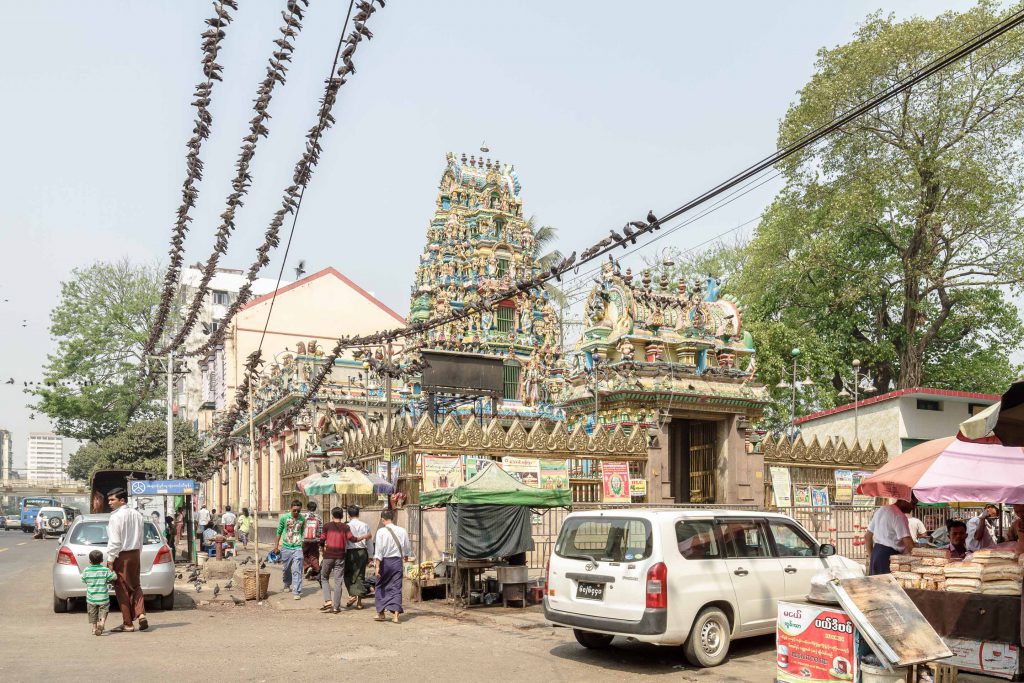
Former Myanmar Railways Company
Address: Bogyoke Road
Year built: 1877
Architect: Unknown
As one of the oldest surviving colonial-era buildings, the former Railways Company predates the Third Anglo–Burmese War in 1885. In 2013, extensive renovations began: these will place the building at the heart of the ambitious “Landmark” project, which is described in the section on the FMI Centre. Eventually Asian luxury group Peninsula will run a five-star boutique hotel within these walls. Local business tycoon Serge Pun planned to convert this building into a high-end office complex when he signed the original lease for the whole plot in the 1990s. However, the Asian financial crisis foiled the idea.
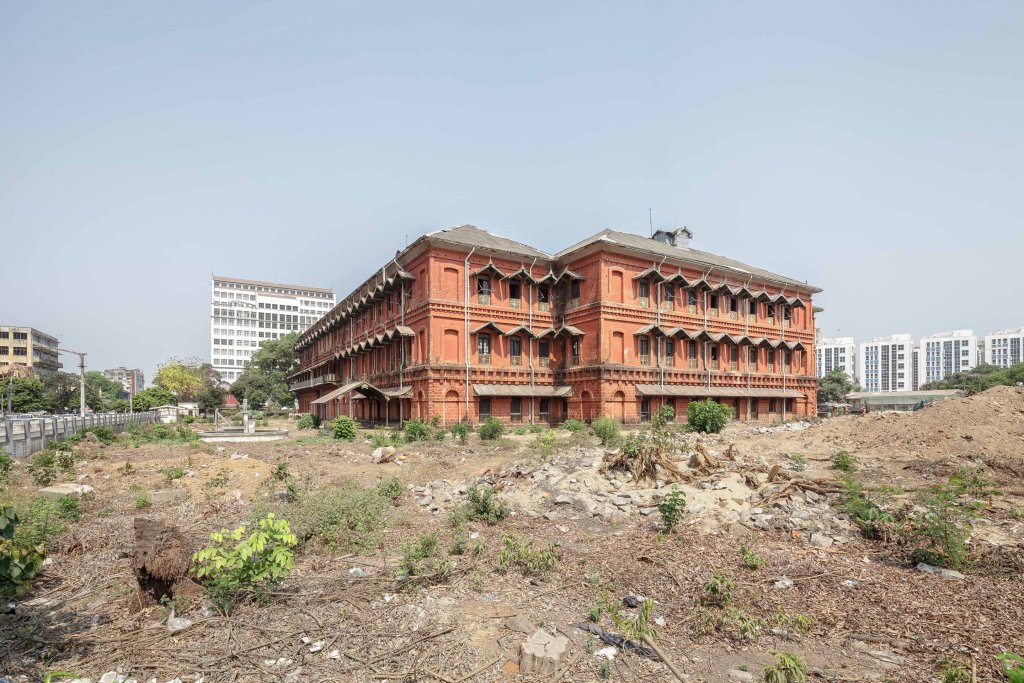
This busy intersection of Sule Pagoda and Bogyoke Roads is one of Yangon’s focal points: Bogyoke Market is nearby to the west, Sakura Tower and Sule Shangri-La are right across the street. The former Railways Company building can best be admired from that side. The laterite blocks on the first floor and the red bricks used everywhere else give the building its distinctive, glowing shade. The use of laterite also explains the structure’s durability compared to other colonial-era buildings. The ornate awnings dominate the façade from the Bogyoke Road side. They are cast from iron and were imported from Scotland. Singaporean firm Lapis, specialising in heritage conservation, has been contracted to oversee the renovation works. The building’s lack of maintenance prior to the renovation work was most visible in the inner courtyard. It will likely be covered with a glass ceiling once works are completed in a few years’ time.
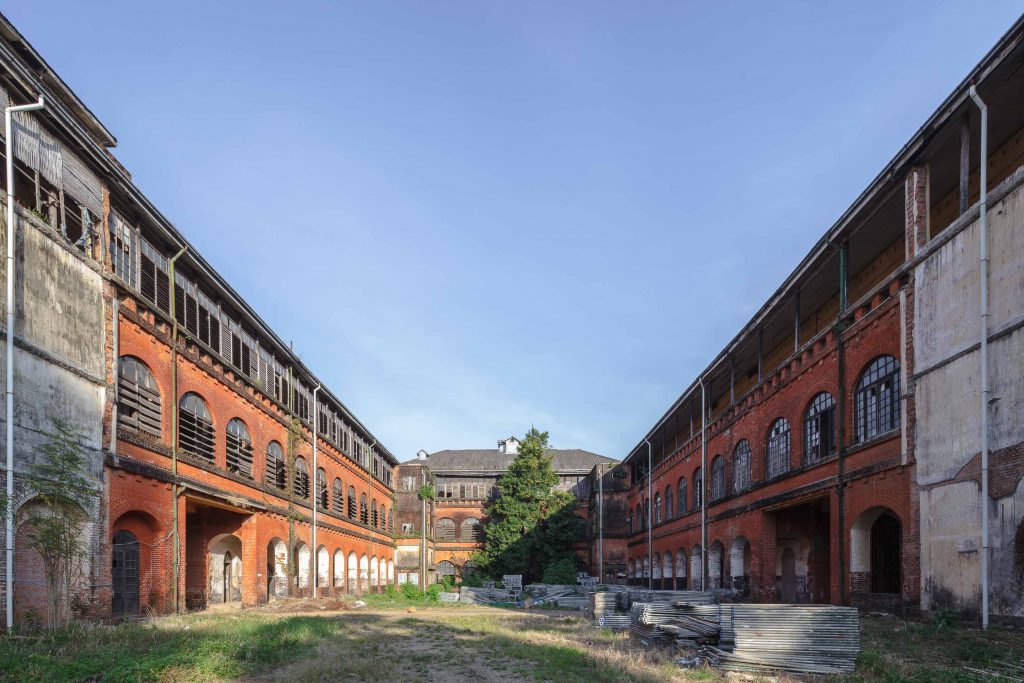
In the late 19th century, the growing railway system was administered from these premises. Coinciding with its completion, Burma’s first railway line opened in 1877 and connected Yangon with Pyay (Prome); a distance of 250 kilometres. The railways later became a private company. By 1909, the system expanded to a length of more than 2,400 kilometres, connecting about 250 stations and reaching up to the Chinese border. The famous viaduct across the Gokteik Gorge, north of Mandalay, opened in 1901. Built by US companies and using US steel, its maximum height is 100 metres, symbolising the vaulting ambition of those early railway entrepreneurs.
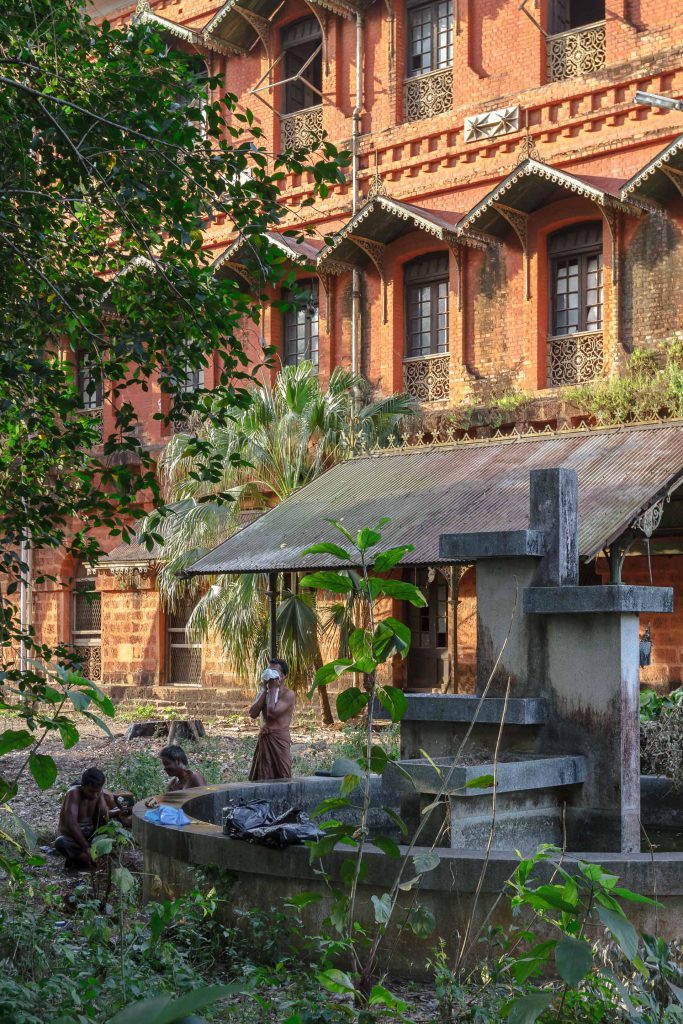
FMI Centre
Address: 380 Bogyoke Road
Year built: 1995, renovated 2010 (FMI Centre)
Architect: Unknown
Built in the mid-1990s and opened in 1995, the FMI Centre was Yangon’s first major office building up to international standards. (It was followed by the Sakura Tower, which opened in 1999 and remains one of the best office spaces in the city). The rather unremarkable 11-storey building, here seen from 29th Street, hosts the offices of various local and international companies and organisations. The FMI Centre is about 50 metres tall, towering over the low-rise downtown area immediately to the south. The “Parkson” department store in the retail podium opened in 2013, after an extensive renovation by local SPINE Architects. The Malaysian brand expects to invest in several store projects across Myanmar in coming years.
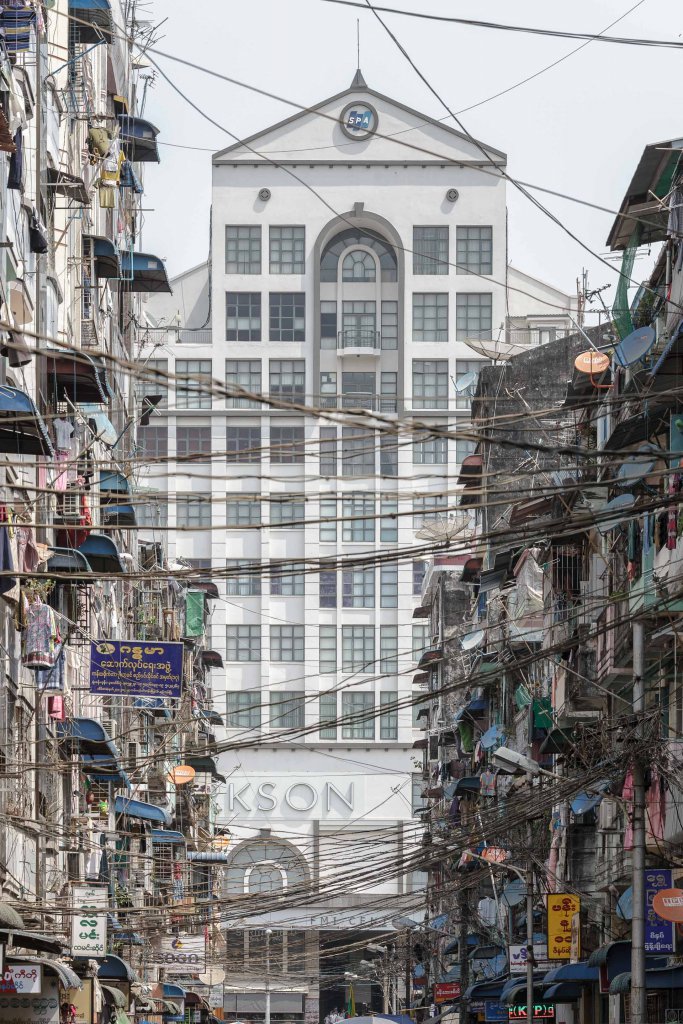
This relatively new building (by current Yangon standards) will soon have to make space for the “Landmark” project, with the former Myanmar Railways Company at its heart. The FMI Centre’s twin building, The Grand Mee Ya Hta Executive Residences, has already been vacated to make space. (By the time our readers venture through Yangon, it may be gone already.) The owner of the buildings and site is Serge Pun, one of Myanmar’s foremost businessmen. His many ventures include a banking group, a hospital, an airline, coffee plantations and domestic real estate. The latter earns the group the most money, and a few key projects provide the financial backbone to the thriving conglomerate. At the time of writing, the group’s major cash earner is Star City, a residential project in Thanlyin across the Yangon River.
Landmark’s completion will fire the starting pistol for a new phase in the history of Yangon real estate. Budgeted at around 500 million US dollars, it will compete neck-and-neck with the mixed-use project of Vietnamese developer Hoang Anh Gia Lai, on Kaba Aye Pagoda Road, for the priciest-ever real estate deal in the city. Two of Landmark’s four projected towers (of about 80-100 metres each) will provide office space, while the other two will house a four-star hotel and serviced apartments. Aedas, one of the biggest architectural firms in the world, will handle the design. Early renderings reveal a generous use of glass and a connected retail area at the base of the four buildings, as well as swimming pools on their roofs. The four towers will flank the former Myanmar Railways Company building.
The Washington-based International Finance Corporation (IFC), the private-sector arm of the World Bank, has committed 70 million US dollars to the overall project cost. The Asian Development Bank followed suit, approving the same amount. This sets Landmark miles apart from other major construction projects currently under way in Yangon, especially given the IFC’s stated attachment to transparency and accountability. The intention is to signal to foreign investors that the time to invest in Myanmar has come—and that trustworthy local partners await. Parts of Serge Pun’s business empire are already being traded on the Singapore stock exchange—to date, one of few ways for Western investors to gain exposure to Myanmar’s markets.
But all may not be so rosy in the end. At the time of writing, the project is already late by about a year. Serge Pun has so far failed to secure a critical lease extension. The whole four-hectare site still nominally belongs to the Ministry of Railways; it says that it is still studying the application, telling the Myanmar Times that it was not “malicious in its intent or purposely trying to prolong the process”. Since Serge Pun began leasing the plot in the 1990s, only about 25 years remain on the current lease—too little to secure long-term investments. However, he remains optimistic the deal will come through, albeit in two stages. The first one will include the office, retail and hotel components. Then, once the extended leases are obtained, the residential part of the project will get underway.
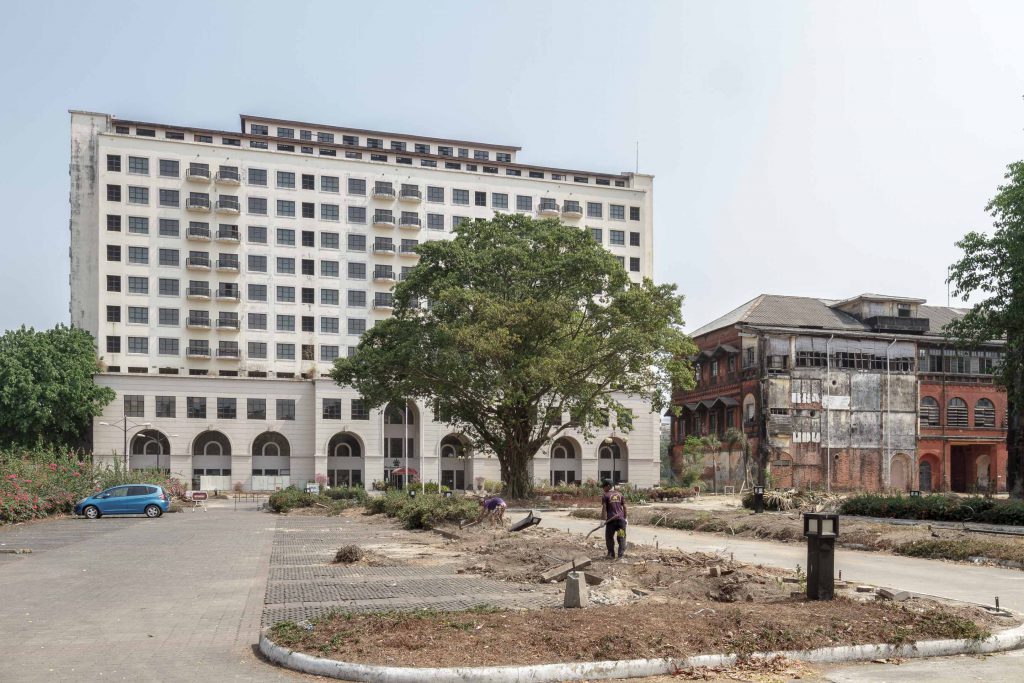
The big question is whether the international financial institutions will continue to support the project in the absence of this critical lease extension—and if it is granted, on the lease conditions. Yangon’s real estate market has run into major capacity shortages and a frenzy of construction activity is taking place throughout Yangon. But conditions are incredibly volatile: in February 2015, several major construction projects for commercial and residential space already under way were suddenly suspended due to concerns over their proximity to the Shwedagon Pagoda. In the meantime prices are astronomical, although the market is showing signs of cooling. Serge Pun himself believes a crash in prices is likely.
